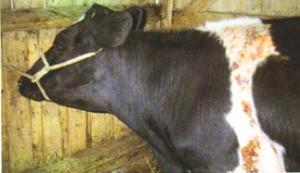Photosensitization
 |
| Photosensitization |
|
© William Ayako, Kari Naivasha
|
Photosensitization is a condition in which areas of skin exposed to light and lacking sufficient protective hair, wool or pigmentation, are very sensitive to sunlight due to the presence of chemicals called photodynamic agents.
Photodynamic agents (or photosensitizing substances) are activated by light, and may either be in something the animal eats (and cause primary photosensitization) or be formed in the animal's body due to faulty excretion through the liver (and cause secondary photosensitization).
Many chemicals, including some that are fungal and bacterial in origin, may act as photosensitizing agents. However, most are from plants.
The condition occurs world-wide and is most commonly seen in cattle, sheep, goats and horses.
Primary photosensitization occurs when the photodynamic agent is absorbed either through the skin or the gastrointestinal tract unchanged, and reaches the skin in its original form. Livestock are usually affected within a few days of eating the plant when it is lush and green and growing rapidly. In most cases the plant responsible must be eaten in large amounts and is usually the dominant plant in the pasture.
 |
| Lantana Plant |
|
© William Ayako, Kari Naivasha
|
Examples of plants causing primary photosensitization include St. John's Wort, buckwheat, wild carrot, perennial rye grass, certain species of clover and lucerne and spring parsley. In addition some coal tar derivatives, phenothiazine, sulphonamides, and tetracyclines have induced primary photosensitization.
Secondary photosensitization is by far the most common form seen in livestock. The photosensitizing agent is in all cases phylloerythrin which is a normal end-product of plant chlorophyll excreted by the liver. When the liver is not functioning properly and fails to excrete it, pylloreythrin accumulates in the blood and may reach levels in the skin which make it sensitive to light.
A number of plants contain liver poisons that may result in secondary photosensitization if eaten in sufficient quantities, including:
1. Lantana camara, ornamental garden shrubs, which have become wild in many parts of the world and are now found throughout sub Saharan Africa. Lantana poisoning is virtually confined to cattle.
2. Tribulus terrestris/devil's thorn is a ground creeping plant with yellow flowers widespread throughout the tropics; it is regularly eaten by livestock without causing problems, but is also suspected to cause photosensitization.
Numerous other plants including ragwort, lupin, bog asphodel, panic and millet grasses may also cause secondary photosensitization, as may various fungi contaminating several species of grass.
Photosensitization also occurs as a result of poisoning or infections which damage the liver. Infections include Leptospirosis in which the initial infection is in many cases followed by severe jaundice and photosensitization.
Signs of photosensitization
Regardless of the cause the symptoms are similar in all cases.
- Only pale areas not covered by a heavy coat of hair or wool are affected. Light on these sensitive areas causes swelling and intense irritation. The difference between affected and normal skin is usually very marked. Black skin is unaffected while white skin is targeted. Loss of skin is common in the terminal stages.
- The skin wounds are most common in those areas exposed to solar rays, such as the back, the flanks, nose, the vulva and the teats.
- Often the first sign is a cow stamping her feet in discomfort. The teats appear reddish and are very tender. The muzzle and vulva may appear to be swollen and peeling.
- White skin may feel dry and have the feeling of parchment while adjacent black skin feels smooth and soft.
- Affected animals seek shade and may rub the affected parts on bushes and posts.
- With time the affected skin dies, dries and peels off. It should never be pulled off.
- Usually affected animals are not ill, although on occasion they can be, depending on the cause of the photosensitization.
- If there is severe liver damage the mucous membranes may sometimes become yellow.
Prevention - Control - Treatment
- General treatment includes immediate removal from direct sunlight, removal from the paddock in which the animals have been grazing and the administration of laxatives such as liquid paraffin to eliminate toxic materials already eaten.
- Some plants are only poisonous at certain times and the pasture may be safe to return to later in the year.
- Remove known poisonous plants in pastures by digging or burning out.
Treatment of the wounds depends on their stage. Antihistamines should be given immediately. Corticosteroids, given in the early stages may be helpful, but must NEVER be given to pregnant animals as it will make them abort.
Secondary skin infections and suppurations should be treated with basic wound management and Fly Strike prevented.
Most wounds heal remarkably well, even after serious infection.
